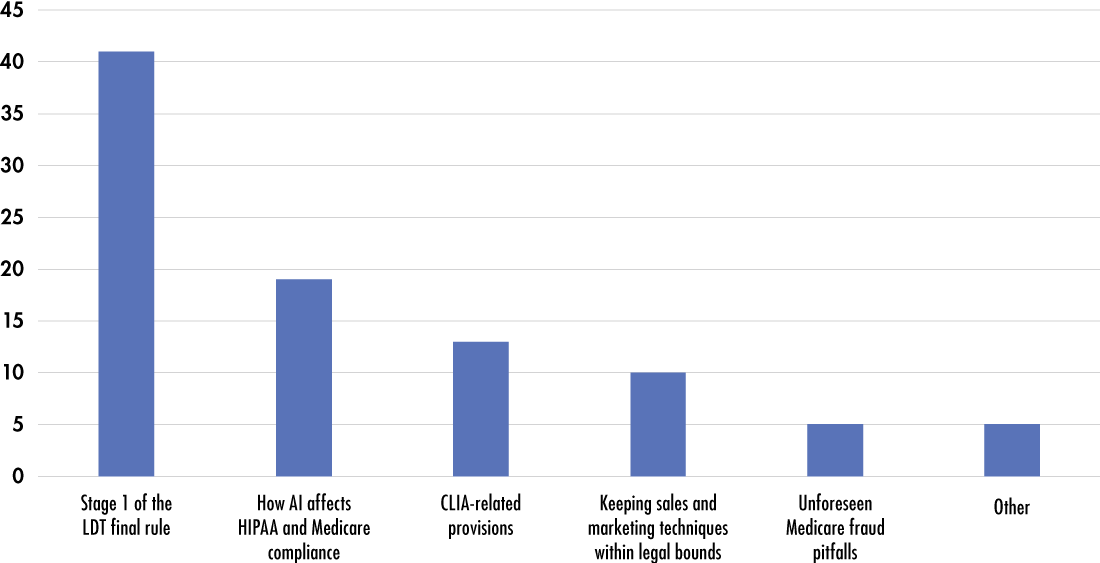Special Report: Preparing for Stage 1 of the FDA’s LDTs Final Rule
Considerations for addressing compliance with Stage 1 of the FDA’s lab-developed tests final rule

With the election of Donald Trump earlier this month, along with recent legal challenges, lab leaders may have been hopeful for a quick end to the FDA’s final rule giving the agency authority over laboratory-developed tests (LDTs). However, the consensus of most regulatory experts is that labs should at least prepare to comply with Stage 1 of the final rule, as any action to halt the rule likely wouldn’t take effect before the May 6, 2025, deadline. Even in the unlikely event the rule is halted before Stage 1, FDA regulation of LDTs will probably come to pass eventually, experts say.
Election results and lawsuits unlikely to stop Stage 1
During G2 Intelligence’s November 2024 Lab Institute Virtual Event, which ran on November 12 and 13, regulatory attorney Christine Bump pointed out that all documents related to lawsuits filed against the FDA are due by December 31, 2024, and the court likely won’t make a ruling on the consolidated cases until February 2025 at the earliest. Therefore, even if the court rules in favor of the plaintiffs, the LDTs rule likely won’t be halted before the Stage 1 implementation deadline.
In earlier comments on LinkedIn, Bump explained that the incoming Trump administration also won’t be able to just stop the LDT rule, and it likely won’t be a top priority for them, so labs shouldn’t expect a change in government to lead to a speedy end to the rule either. In other words, if labs haven’t already begun efforts to comply with Stage 1 of the final rule, they will want to get started as soon as possible.
LDTs rule Stage 1 requirements in a nutshell
As a quick recap, Stage 1 of the FDA’s LDTs final rule requires affected labs to comply with the following requirements by May 6, 2025:
- Medical device reporting (MDR)
- Correction and removal reporting
- Quality system (QS) requirements for complaint files
Tips for complying with the LDTs rule Stage 1 requirements
During a panel discussion on LDTs regulation during the G2 November 2024 Lab Institute, regulatory experts Shannon Bennett and Sheila D. Walcoff, JD, offered advice for labs on complying with these Stage 1 requirements in the face of uncertainty around the rule. Here are four key takeaways from their talk:
1. Don’t delay, act now
Bennett pointed out that, because of the current legal challenges to the rule and the upcoming change in government, many labs are taking a wait-and-see approach to compliance as there is a chance the rule could be delayed or thrown out. Though Bennett and Walcoff sympathized with labs not wanting to spend time and money on a rule that may not go ahead, both urged labs to start compliance efforts for Stage 1 as soon as they can, despite the uncertainties.
“In my opinion, sitting back and doing nothing is not a good idea,” said Bennett, who is director of regulatory affairs for the Mayo Clinic’s Department of Laboratory Medicine and Pathology. “The reason is the regulations are in place today. [Stage 1] is coming up, and it’s only six months away. So as of this moment, we will be expected to comply with [Stage 1]—the adverse event reporting and the complaint handling—come May 6.”
In addition to the deadline for Stage 1 approaching quickly, Bennett added that another reason to start compliance efforts ASAP is that regulatory consultants with specific expertise in FDA requirements for diagnostic tests are in short supply. For labs that require external expertise to help with compliance, securing the services of such experts as soon as they can is therefore critical. Walcoff added that getting someone who’s also familiar with CLIA will be essential to help labs ensure that their compliance efforts for the LDTs rule don’t overlap with those required for CLIA.
“There’s not this clean segregation between what’s FDA required and what’s CLIA required,” said Walcoff, CEO and founder of regulatory consulting firm Goldbug Strategies. “It’s really all encompassing and overlapping, and it’s helpful to avoid having two completely different systems in place, because that’s how mistakes start to get made.”
2. Define complaints and adverse events
Walcoff said that a key first step is to understand and define what complaints and adverse events are in relation to a lab’s test and when the lab would need to report them. To help come up with these definitions, at a bare minimum, labs should get down on paper what their test does and define what could happen due to a false result, Walcoff suggested.

“That’s really where FDA always starts, the risk of a false positive [or] false negative,” Walcoff said, adding that from there, labs can come up with a process for handling such complaints and adverse events. However, she adds that, for labs looking to do the bare minimum to comply because of uncertainty around the LDTs rule, there is no fast and easy way to ensure full compliance. To be fully compliant, labs will need to invest in enough documentation—likely around seven or eight policies and procedures—that cover the systemic approach they will take when it comes to complaints and adverse events, Walcoff said. Such policies will need to:
- Define how the lab will handle complaints or notifications of adverse events when they come in
- Define the criteria these complaints and events will have to meet to be reported to the FDA
- Clearly document the lab’s process for handling complaints and adverse events to demonstrate compliance
To this advice Bennett added labs should at least identify—on paper—what gaps are present in their current complaint handling and adverse event management processes, so they know what to focus on right away. Waiting until April 1 to identify these gaps will likely be too late, he said.
3. Focus on patient safety and protecting public health
Walcoff said that, despite the upcoming change in administration and the ongoing lawsuits against the FDA’s final rule, one thing that probably won’t change is the FDA’s focus on protecting public health. Focusing compliance efforts on elements of the final rule that will likely be kept—those that involve protecting public health and patient safety—is a good idea, she stressed.
“Find the ways to add that quality to your system,” she said. “That is an approach that can be very protective. It can be one of those tools that you can use to mitigate the risk of further enforcement.”
In terms of quality requirements, as part of Stage 1, labs will need to comply with the FDA’s quality system requirements for complaint files. Walcoff points out that these quality requirements are not the same as those for CLIA, College of American Pathologists, or the New York Clinical Laboratory Evaluation Program. Labs that already have a quality system in place will therefore need to look closely to see where it covers FDA requirements, and where gaps exist.
As covered in Bump’s Lab Institute presentation, the current FDA quality requirements (found at 21 CFR Part 820) for medical devices will be harmonized with ISO 13485 by February 2026. Bump noted, however, that there will be some deviations from ISO in the FDA’s new Quality Management System Regulation. Essentially, in areas where current FDA regulations differ from ISO’s, the FDA requirements will take precedence. In addition, unlike the LDTs rule, Bump said that the FDA’s move to harmonize their current QS requirements with ISO 13485 has been met with widespread support from key medical device stakeholders as most “agree that this harmonization will ease their overall regulatory burden.” Focusing on these quality requirements is therefore a good idea when tackling LDT rule compliance.
4. Don’t underestimate the resources required to comply
Though the cost and time involved in compliance will vary depending on the lab, the systems they currently have in place, and how many affected tests they have on their menus, Bennett stressed for lab leaders to not underestimate the resources required.
“Even just in [Stage 1], you need a dedicated group to manage complaints, and the documentation requirements will be greater,” he said. “Moving into [Stage 2], just gathering and maintaining—over time—all that labeling information and listing information, that’s going to be a lot of work. Planning on disseminating that to your existing staff probably isn’t a winning approach, particularly the larger your menu is.”
Labs should plan for additional full-time equivalents [FTEs] in order to be compliant as the milestones come up, Bennett continued.
Walcoff added that training is another key aspect that lab leaders will need to account for.
“I think there’s a significant training component that is underestimated, whether it’s understanding how to figure out, ‘where do my tests even fall among these [affected LDTs]?,’” she said. Walcoff added that labs shouldn’t wait to start getting answers to these sorts of questions and should ensure their staff are adequately prepared, as labs’ “current FTEs are probably not going to want to work through the holidays to make sure [labs are] compliant on this.”
Moving toward compliance
Though labs may wish to save time and money now by waiting to comply with the FDA’s LDTs rule, doing so may prove more costly in the long run. In addition to the reasons mentioned above, Walcoff added that other entities surrounding the lab, such as investors, are taking notice of the final rule and asking questions about how labs are managing compliance risks related to it. She added that issues related to the change in the US government are usually presented as clear cut, where the outgoing administration is supportive of tight regulations while the incoming administration is seen as anti-regulatory. However, the fate of the LDTs rule may not be as simple as it being outright eliminated.
“It sounds always very black and white,” Walcoff said. “The answer may not be black and white…it could be right in the middle.”
Because FDA regulation of LDTs likely won’t disappear completely and likely not before the May 2025 deadline for Stage 1, lab leaders who haven’t already started their compliance efforts—particularly those with more than one impacted LDT on their menus—will need to get started right away. Walcoff said that reaching out to regulatory experts to understand the full scope of compliance is an important first step to figuring out the time and resources labs will need.
“Get some advice and figure out your overall strategy and prioritize this,” she said. “It becomes very overwhelming from a cost, time, and personnel management perspective to try to eat the whole elephant at once, so to speak.”
Subscribe to view Premium
Start a Free Trial for immediate access to this article